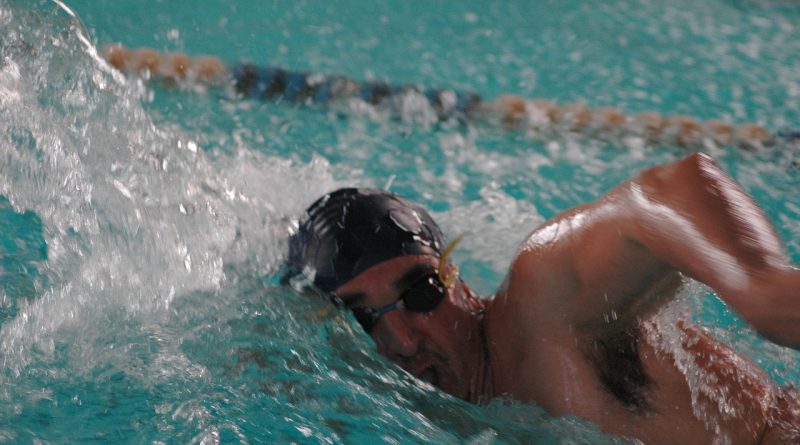Exploring Swimming Orientation – Front Crawl
The front craw (or freestyle) is potentially the most efficient and fastest of the swimming strokes. It is swum in continuous, flowing action, with the head leading the body through the water like the prow of a ship. When you swim face-down (prone) you can allow your body to extend naturally and can use your arms with maximum flexibility for propulsion. This stroke offers a good opportunity to explore the experience of release and forward orientation in the water.
An efficient front crawl requires sensitivity to the changing point of balance along the entire length of the body. The alternate rotation of the arms allows the body and limbs to remain extended as they slice through the water. A useful image is that of a long boat moving forward without a break with a continuous rhythm of propulsion, rather than the push-and-release that gives the breaststroke its characteristic ebb and flow. Longer and proportionately thinner vessels are more streamlined than shorter, broader ones, and this principle applies equally to the way the body lies on the water. In the crawl, the arms, back, and legs are extended. The point of balance of this elongated figure is higher up the body towards the head, creating the potential for greater momentum.
Snatching back the arms in a hasty manner reduces the potential benefit of streamlining offered by the elongated body. To overcome this tendency, it helps to continue to direct the extended arm forward until the recovering arm enters the water. The arm should never become rigid. A slightly bent elbow in the underwater part of the stroke allows for greater purchase on the water, and therefore more efficient use of effort in propulsion. As the arm breaks the water surface for the so-called ‘recovery’ phase of the stroke, the elbow should be released so that it bends naturally. You should not make a special effort to bend or pitch the elbow, which involves unnecessary muscle strain and is a cause of tendonitis in competitive swimmers. Free rotation of the shoulder with a released elbow activates the powerful back muscle (the latissimus dorsi) rather than putting strain on the arm and shoulders. A free elbow also allows for a smoother and more controlled entry of the hand into the water, which in turn enables a steadier underwater pull.
Breathing presents the main challenge to retaining good orientation in this stroke. Craning the head and shoulders back to inhale has a particularly adverse effect. Unhurried rotation of the head and hips is all that is required to lift the mouth sufficiently above the water to breathe in. A controlled combination of hip and head roll is the essence of a fluent, elegant front crawl. You may imagine that all you need to do to be in a position to inhale is simply to turn your head 90 degrees to the side. But can you do this, even out of the water, without feeling the pull on your neck muscles? In practice, a hip roll that initiates rotation of the torso gives vital assistance to the process. If the hips contribute half the body roll, the neck muscles only need to rotate the head half as far. This creates more time and ease for breath to be taken without disturbing the balance of the head, neck, and back.
Explore the enjoyable possibilities offered by increased mobility of the hips in the following way. After swimming on your front for a few strokes, roll your whole body over onto your back. Notice how much easier this is if you treat the body as a unit. Imagine starting the movement from the hips, instead of twisting your head and neck and letting your torso follow. Incorporate the sensation of rolling your whole body unhurriedly into the continuous action of the stroke. You can remind yourself to start the outward roll from the hip, and the return roll leading with the head, by repeating rhythmically as you perform the action ‘Hips: – roll out. Head: – back in.’
The use of the arms in the crawl, as in the backstroke, also affects orientation. An excessive effort with the arms can force the head backward. Since propulsion is generated by the arm pull beneath the water, crashing the arms down into the water is both a waste of energy and militates against the control needed to prepare an effective pull. If the hand enters at a wide angle to the body it disturbs the balance. Equally, a narrow entry – when the hand enters the water at a point within the width of the shoulders – causes the body to wobble unevenly. When swimmers with this tendency first try to bring their hands into the water at a wider point of entry than they’re used to, they frequently feel that their arms are entering the water significantly more widely than they actually are.
The problem of placing the hand correctly on its re-entry into the water offers a prime instance of what the Alexander Technique calls unreliable sensory appreciation. The faulty arm action may have become so ingrained that it feels right. When we come to modify it, to start with it feels wrong. Learning the art of swimming is a continuous process of development and refinement of motor skills. We should not, therefore, limit ourselves by relying solely on our feelings.


